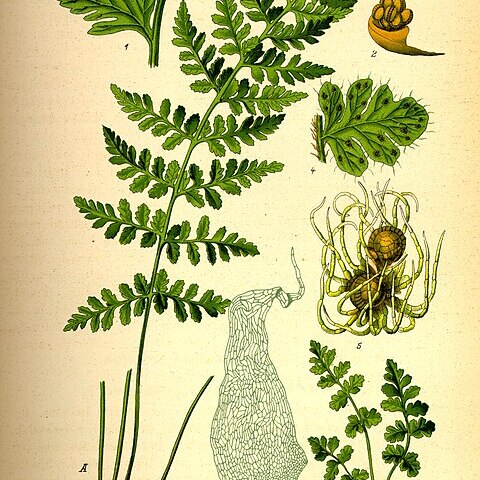Plants 8-12 cm tall. Rhizomes compact, ascending, with cluster of persistent stipe bases of ± equal length; scales concolorous, brown, lanceolate, ca. 5 mm, membranous, fimbriate. Fronds clustered; stipe reddish brown, lustrous, 1-2 cm, ca. 1 mm in diam., articulate below middle, sparsely scaly, and scales later fallen; lamina 1-pinnate-pinnatifid, lanceolate, 5.5-9 × 1-1.7 cm, herbaceous or thinly herbaceous, both surfaces glabrous, base attenuate, apex acuminate; rachis with sparse long hairs and linear-lanceolate scales; pinnae 9-11 pairs, separate, oblique; lower pinnae shorter than above, ovate, 2-3 mm; middle pinnae largest, ovate or deltoid-ovate, 5-9 × 4-7 mm, pinnatifid, with 3 or 4 pairs of lobes, apex acute; pinna lobes hemielliptic, 2-3 mm, margin usually involute when dried. Veins pinnate, ending in hydathodes close to laminar margin, obvious adaxially. Sori orbicular; indusia saucer-shaped, with fimbriate long-ciliate margin. 2n = 156.
Rhizome-scales lanceolate or lance-ovate, 4-6 × 1-2 mm, brown, denticulate, sparsely fimbriate; lvs 6-15 cm; petiole bright brown, sparingly scaly and hairy, articulate below the middle; blade linear, 1-2 cm wide, slightly narrowed below, pinnate-pinnatifid, sparsely hairy on the rachis and lower surface, the rachis also sparsely scaly; pinnae sessile, 8-15 pairs, ovate, obtuse, deeply pinnatifid, the segments 2-3(4) pairs, oblong to suborbicular, the lower sublobate, not ciliate; indusium a small disk with a few long septate marginal hairs; 2n=156, thought to be an alloploid derived from nos. 1 [Woodsia glabella R. Br.] and 3 [Woodsia ilvensis (L.) R. Br.]. Rock crevices in cool sites; circumboreal, s. to N.S., Vt., N.Y., Mich., and Minn. A sterile triploid hybrid with no. 3 [Woodsia ilvensis (L.) R. Br.] is W. ×gracilis (G. Lawson) Butters.

